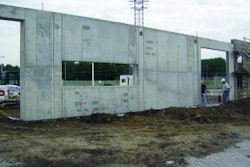
Associated Builders and Contractors (ABC) today reports the nation's Construction Backlog Indicator (CBI) reached 5.9 months in September 2009, 3.2 percent higher than in August. CBI is a forward-looking measurement of the amount of construction work currently contracted to be completed in the future.
"While the CBI edged higher in September, backlog generally remains uncomfortably small, particularly for firms in the heavy industrial category. With the exception of firms operating in the infrastructure category, overall backlog remains weak," said ABC Chief Economist Anirban Basu.
"As with data collected in recent months, September's figures continue to reflect the impact of the stimulus package signed into law in February. It is expected that the peak of infrastructure-related stimulus spending will occur sometime during the first half of 2010," said Basu. "Although backlog within the infrastructure category remains elevated, it is no longer rising, which indicates the likelihood that infrastructure-related spending will slow once the stimulus funds have been exhausted. However, a timely new surface transportation bill could alter that expectation."
ABC's CBI is the only reliable leading economic indicator focused on the U.S. commercial, institutional, industrial and infrastructure construction industries at this level of detail. The indicator is published bi-monthly and data are collected from ABC members on an ongoing basis.
Regional Highlights
The average backlog for September rose in all regions with the exception of the South, where CBI fell slightly by 0.05 months from August to 5.76 months, or roughly 0.9 percent.The West had the largest monthly backlog increase from August to September, up 0.5 months to 6.3 months, or a healthy 8.1 percent.The backlog for the Northeast region rose 6.2 months in September, up 7.3 percent from August. The Middle States registered a modest increase in September of 0.2 months in backlog, or 3.5 percent.Regional Analysis
"Although the Middle States category includes economically beleaguered states such as Michigan and Ohio, there is also a group of states that continues to enjoy low unemployment rates and more stable construction activity, including Minnesota, North Dakota and South Dakota, among others," said Basu. "Despite recent backlog stability, the Middle States continue to report the lowest backlog, followed by the South, which is home to several states that have been among the most dramatically impacted by the broad economic downturn that began in late 2007, including Florida, Georgia, South Carolina and North Carolina."
Industry Highlights
The heavy industrial category is now associated with the shortest backlog. In September, heavy industrial backlog was down to just 4.5 months. This compares to 6.5 months registered in November 2008.Although the infrastructure category continues to enjoy the lengthiest backlog at 9 months, backlog has now declined for two consecutive months.Commercial and institutional sectors saw a modest increase as backlog went from 5.35 months in August to 5.58 months in September.Industry Analysis
"Privately financed construction continues to be weak, which is reflected in still stagnant backlog within the commercial and institutional, and heavy industrial categories. In terms of heavy industrial, never has backlog been this low for any given month for any industry category," said Basu. "Despite the length of infrastructure backlog, the steady decrease in this category is worrisome and may be a reflection of the post-stimulus decline in infrastructure spending due to tight private credit."
Highlights by Company Size
Companies with less than $30 million in revenue saw their respective backlogs increase 1.8 percent from August to September to 5.2 months.Backlog for companies with annual revenues of $30 million to $50 million rose even more sharply to 5.3 months, a gain of 13.2 percent. Backlog also rose among companies with $75 million to $100 million in annual revenues.Companies with annual revenues exceeding $100 million continue to experience declining backlog. In September, backlog fell 8.2 percent from August to 6.6 months.Company Size Analysis
"As was the case during the summer months, momentum appears to be building among smaller firms as activity from larger firms spills over to them. This is a predictable aspect of economic stimulus and has become increasingly apparent in the data," said Basu. "The sweet spot appears to be in the $50 million to $75 million annual revenue category. The backlog for that group remains around 8 months, the lengthiest backlog among all size categories ABC monitors."
About the CBI
Construction backlog is the amount of work, measured in dollars, that companies are contracted to complete in the future. A high backlog value (measured in months) indicates abundant work projects are due to begin in the near term, with predictable overall economic benefits. Conversely, a low backlog indicates fewer work projects are under contract, leading to more uncertain economic impact. Excessively small backlogs mean contractors are running low on available work and need to identify and secure additional sources of future revenue.
The formula ABC uses to convert reported backlogs measured in dollars into months of available work is: current month's level of backlog (reported in dollars) ÷ Fiscal Year 2008 revenues (base year) × 12 = total months of forward-looking work under contract. To maximize the comparability of one month versus another, ABC has worked to maximize consistent reporting among survey sample participants. The effort has been supported by the longstanding relationships between ABC and its members, as well as carefully crafted communications with those responsible for responding to each monthly survey.
Associated Builders and Contractors (ABC) is a national association with 79 chapters representing 25,000 merit shop construction and construction-related firms with two million employees. Visit us at www.abc.org .
Download a PDF of the CBI charts and graphs and the CBI methodology .
Photos/MultimediaGallery Available: http://www.businesswire.com/cgi-bin/mmg.cgi?eid=6100941&lang=en

















